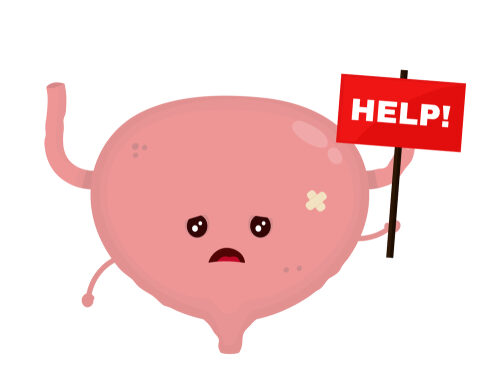Feeling beholden to your bladder? Stuck on the toilet for hours at a time? Pain before or during urination? An almost constant ache above the pubic bone? Never able to get completely emptied? Feeling like you have a UTI but tests are always negative?

You may be experiencing bladder pain syndrome (BPS), sometimes called painful bladder syndrome or interstitial cystitis (IC). The Society for Urodynamics and Female Urology (SUFU) and the American Urology Association (AUA) define BPS “as an unpleasant sensation (pain, pressure, discomfort) perceived to be related to the urinary bladder, associated with lower urinary tract symptoms of more than six weeks duration, in the absence of infection or other identifiable causes.”
Before we dive into this condition, let’s talk about what’s typical for a healthy bladder. It is normal to urinate every 2-4 hours during the day, and 0 times per night for adults under the age of 60. Urination should not be painful, and you should not have to push or strain to empty.
BPS can make emptying the bladder painful and difficult, and result in frequent trips to the bathroom. It is also often associated with fatigue and other chronic pain syndromes. And may lead to depression and isolation as it becomes difficult to leave the home for fear of not being able to find a bathroom. It does not typically result in urinary leaks, but can. Because its cause is still not well understood, BPS can be a very difficult and frustrating condition to have.
Etiology/Causes
While the exact cause of BPS is not known, it may develop after a UTI or other infection, fall on the tailbone, after surgery, or other stressors. It is more common in women, but can also happen in men. Sometimes symptoms flare with increased stress, sexual activity, constipation, or after certain dietary triggers (acidic foods and drinks, alcohol, and caffeine). Some folks may go weeks or months without a symptom flare while others feel pain daily. There is a component of nervous system hypersensitivity (nerves in the pelvis become extra sensitive and responsive) in most cases of BPS.
Who Should You See?
Having a good care team is key when treating BPS. It is helpful to see a gynecologist, urologist, and/or urogynecologist to rule out infection and other major pathologies. Sometimes a urologist or urogynecologist will use a camera/scope in the bladder to look for ulcers in the wall called Hunner’s lesions. Because there may be dietary triggers of symptoms, a dietitian is extremely helpful. And of course, a pelvic floor physical therapist is crucial in helping you work on the surrounding muscles and nerves.

Treatment
Because there is no known cure for BPS, treatment is focused on symptom management. This may include medication prescribed by your medical team. If there are dietary triggers, you may consider eliminating or reducing their consumption. If constipation is also present, this must be addressed (think fiber, fluid, and Squatty Potty). Because pelvic floor muscle tightness is also frequently associated with BPS, working with a pelvic floor therapist to retrain and relax these muscles through exercise, manual therapy, and/or biofeedback can be helpful. Bladder training and progressively lengthening the time between bathroom breaks may be indicated. Meditation, regular exercise, and other stress management strategies are ways to address a hypersensitive nervous system, and working with a counselor or therapist is crucial to finding strategies that work best for you.
So if you’ve been diagnosed with BPS, or you have some of these symptoms and are wondering where to go next, give us a call at (919)571-9912 to schedule your free 10-minute phone consultation today.
For more information on IC/BPS visit the AUA website for the most current guidelines regarding diagnosis and treatment.

